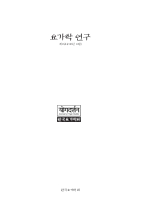- 영문명
- A study on Nāḍiśodhana (nadi-purification method) of Haṭhayoga
- 발행기관
- 한국요가학회
- 저자명
- 김태희(Taehee Kim)
- 간행물 정보
- 『요가학연구』제34호, 9~46쪽, 전체 38쪽
- 주제분류
- 인문학 > 철학
- 파일형태
- 발행일자
- 2025.09.30
7,360원
구매일시로부터 72시간 이내에 다운로드 가능합니다.
이 학술논문 정보는 (주)교보문고와 각 발행기관 사이에 저작물 이용 계약이 체결된 것으로, 교보문고를 통해 제공되고 있습니다.

국문 초록
나디-정화법은 초기 작품인 고락샤의 백송(Gorakṣaśataka, GŚ, 11-13 세기)을 비롯해서 바시스타상히따(Vasiṣṭhasamhitā, VS, 13세기), 요가야갸발끼야(Yogayājñavalkya, YY, 11-3세기), 하타의 등불(Haṭhapradīpikā, HP, 1450년경), 하타의 보석 목걸이(Haṭharatnavālī, HR, 17세기), 게란다상히따(Gheraṇḍasamhitā, GhS, 18세기) 등 대부분의 하타요가 문헌에서 설명되었다.
나디-정화의 기법은 기본적으로 ① 왼쪽 코로 숨을 마시고 ② 그숨을 하복부에 최대한 유지한 후 ③ 오른쪽 코로 내쉬고 ④ 다시 오른쪽 코로 숨을 마시고 ⑤ 최대한 참은 후 ⑥ 왼쪽 코로 내쉬고 다시①∼⑥의 과정을 반복한다는 점에서 동일하다. 하지만 숨을 마시고, 참고, 내쉴 때 종자음을 염송을 하는지 여부, 그리고 명상의 대상이무엇인지에 따라 약간의 차이가 있다.
하타요가 문헌이 공통적으로 나디-정화의 중요성을 언급했지만 특히 바시스타상히따(VS)와 요가야갸발끼야(YY)는 나디-정화법과10 요가학연구 제34호(2025. 9) 별개로 ‘나디-정화법에 기반을 둔 특별한 호흡법(prāṇāyāma)’을 설명하고 있다. 두 문헌에서 설명된 호흡법은 ‘나디-정화법과 동일하되 중간에 종자음 염송이 추가된 기법’이다. 이와 유사하게 샤릉가드하라선집(Śārṅgadharapaddhati, ŚP, 14세기)도 이 기법을 나디-정화법으로 분류했던 것이 아니라 팔지-요가의 네 번째 지분인 호흡법(prāṇāyāma)으로 규정했다. 또한 요가의 성전(Yogaśāsatra, DyŚ, 13세기)은 이 기법을사히따-꿈브하까(sahita-kumbhaka)로 규정했다.
18세기 작품으로 약 50여개의 꿈브하까를 설명하는 꿈브하까 편람(Kumbhakapaddhati, KP)도 ‘나디-정화-꿈브하까’를 16번째의 기법으로설명했다. 이 점에서 나디-정화법은 그 자체로도 중요하지만 ‘그것에기반을 둔 하나의 구체적 호흡법’이기도 했다는 것을 알 수 있다.
본고는 나디-정화의 기법을 먼저 검토한 후 ‘나디-정화법에 기반을둔 호흡법’을 다루고자 한다
영문 초록
The Nāḍiśodhana practices are described in most Haṭhayoga texts, including early works such as the Gorakṣaśataka (GŚ, 11th-13th centuries), Vasiṣṭhasamhitā (VS, 13th century), Yogayājñavalkya (YY, 11th-13th centuries), Haṭhapradīpikā (HP, circa 1450), Haṭharatnavālī (HR, 17th century), and Gheraṇḍasamhitā (GhS, 18th century).
The techniques of Nāḍiśodhana are fundamentally the same, involving the following steps: ① Inhale through the left nostril, ② retain the breath in the lower abdomen for as long as possible, ③ exhale through the right nostril, ④ inhale through the right nostril, ⑤ hold the breath for as long as possible, and ⑥ exhale through the left nostril. This cycle (steps ①-⑥) is repeated. However, there are slight variations depending on whether the practitioner recites a bīja mantra while inhaling, holding, and exhaling, as well as what the object of meditation is.
While Haṭhayoga texts commonly emphasize the importance 46 요가학연구 제34호(2025. 9) of Nāḍiśodhana practices, Vasiṣṭhasamhitā (VS) and Yogayājñavalkya (YY) in particular describe a “special breathing technique (prāṇāyāma) based on Nāḍiśodhana,” which is distinct from the basic Nāḍiśodhana practices. The breathing technique explained in these two texts is essentially the same as Nāḍiśodhana, but with the addition of a bija mantra recitation during the process. Similarly, Śārṅgadharapaddhati (ŚP, 14th century) does not classify this technique as a Nāḍiśodhana method, but rather defines it as a breathing technique (prāṇāyāma), which is the fourth aspect of the Eight-Limbed Yoga (aṣṭāṅgayoga). Furthermore, Yogaśāsatra (DyŚ, 13th century) defines this technique as sahita-kumbhaka (the combined retention of breath).
Similarly, the Kumbhakapaddhati (KP, 18th century), a work that describes about fifty different kinds of kumbhakas, presents “Nāḍī-śodhana-kumbhaka” as the sixteenth technique. From this we can see that Nāḍiśodhana was not only important in itself, but also regarded as “a specific breathing technique based upon it.” This paper first examines the technique of Nāḍiśodhana and then analyzes the “breathing practices based on Nāḍiśodhana.”
목차
Ⅰ. 머리말
Ⅱ. 나디-정화법의 위치와 유형
Ⅲ. 나디-정화의 구체적 기법
Ⅳ. 나디-정화법에 의거한 호흡법(꿈브하까)
Ⅴ. 맺음말
약호 및 참고문헌
해당간행물 수록 논문
참고문헌
관련논문
인문학 > 철학분야 BEST
더보기인문학 > 철학분야 NEW
- 하타요가 (Haṭhayoga)의 ‘나디 정화법’ (nāḍiśodhana) 연구
- 마음챙김 요가의 신경과학적 메커니즘 - 구조·기능·생리적 변화에 대한 체계적 문헌고찰
- 『바시쉬타상히따』(Vasiṣṭhasaṃhitā) 37) 「요가편」(Yogakaṇḍa) 연구 - 제V장의 번역과 역주를 중심으로
최근 이용한 논문
교보eBook 첫 방문을 환영 합니다!

신규가입 혜택 지급이 완료 되었습니다.
바로 사용 가능한 교보e캐시 1,000원 (유효기간 7일)
지금 바로 교보eBook의 다양한 콘텐츠를 이용해 보세요!



